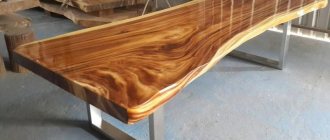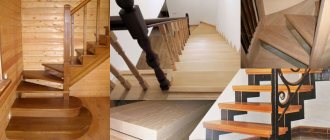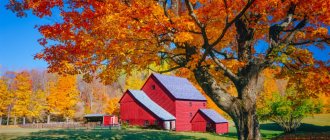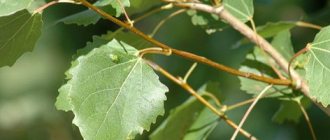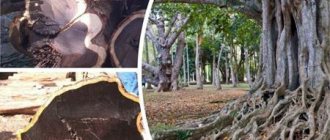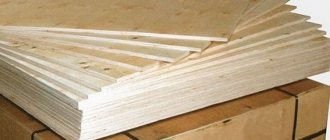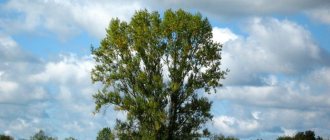Main directions
Wood can serve as a raw material for many products. The producers know all these indicators, I just write all the truths on paper. Let's look today at the criteria by which we can evaluate wood as a raw material for obtaining products; this is necessary when wood is purchased from suppliers. At the same time, when purchasing and agreeing, you can save good money for production. So here are some areas of wood processing:
- Use of wood waste and further production of products from this waste.
- Like wood fuel.
- Using wood for sawing.
- Using wood to produce wooden moldings.
In order to get maximum profit in production, you need to correctly distribute what wood you need, what part of the wood, what species, and then purchase what you need from suppliers. Let's say you cut wood into lumber, and for this you use round wood with rot, you will not receive high-quality products and, accordingly, profit. Or another case, wood has a high percentage of foreign inclusions, where is it better to use it?
Wood of the future
- The future of wood - prospects
- Modern use of wood
- Wood reserves in the world
- Wood production in Russia
- Modern types of wood
In the 21st century, there is a high popularity of traditional, environmentally friendly materials, the main of which can be called wood. This can be explained not only by the environmental friendliness of the raw materials, but also by the fact that modern processing methods significantly improve its performance characteristics and scope of application.
The future of wood - prospects
Anyone who has been to an IKEA hypermarket knows that Swedes are simply delighted with wooden objects. Almost 60% of the state's area is occupied by forests - there are more than 51 billion of them in Sweden. Incredibly, but true - scientists from the Royal Swedish Institute of Technology have invented a method for producing transparent wood. This invention provides enormous opportunities for the use of this material.
Clear lumber will replace clear glass or clear plastic. In the future, it will be used to create containers, double-glazed windows, or bottles for Fanta. The idea for the invention belongs to Lars Berglund. He is a materials scientist who set out to develop a composite, that is, a composite substance based on wood.
Berglund invented a method that is based on the use of wood veneer fibers. The production method is somewhat similar to pulping, during which the lignin is separated. It is because of this that the tree has a brown tint. Next, the lignin is replaced with a polymer substance, and as a result, it is possible to obtain a tree that is 85% transparent. The invented product is characterized by all the features of wood, but at the same time transmits light.
This year, as part of the Technodrev Siberia exhibition, a presentation of an innovative product from the MATERIA company, which came from the Netherlands, took place. Its founder is Els Zeistr. The company is an educational center that stores and applies the most modern knowledge about wood.
“Wood and other biomaterials have been extremely popular in the past. In the process of evolution, people began to use concrete, metals, mineral compounds, and plastic more often. At the same time, the negative qualities of such materials are that enormous amounts of money are spent on their processing. For this reason, today timber products are again gaining popularity, and also claim to be the “material of the future,” noted Els and demonstrated incredible examples of their application.
He said that wood, combined with other components, becomes a completely new product with extraordinary qualities. Among the new products was Arboform or liquid wood. It is a durable and thermoplastic compound, which consists of crushed lumber, the soft tissues of which contain polymers. After such transformations, a compound is obtained that has both the qualities of plastic and wood. The second new product is Dendrolight. This material is very durable, but at the same time much lighter than natural wood. Accoya wood material, created by impregnation with a special acid solution, is characterized by resistance to deformation and durability. In these indicators it is superior to tropical wood.
Thanks to modern developments by scientists, there is already wood that repels drops of water; they are not absorbed, but simply flow off the surface. There are materials that accumulate thermal energy.
Modern use of wood
Today, wood is most often used to build country houses because it is environmentally friendly and natural. Such raw materials are quite popular among designers and architects. Wood is a renewable, natural and inexhaustible resource.
Now the main goals of the modern woodworking industry can be called increasing resistance to moisture, strength, preventing combustion, and bringing the characteristics of wood to the level of building standards. At the same time, craftsmen strive to preserve the natural properties of wood: “breathing” and preservation of “warmth”, as well as appearance. Today, the most popular are laminated wood products, produced from different types of wood using special technology.
As a result of the use of the latest technologies, lumber can be endowed with special qualities, for example, ideal geometry, dimensional stability, and a clean surface.
In our country, the production of glued materials is carried out at woodworking enterprises. Glued laminated wood structures are used very widely in construction. The highest economic effect from the use of glued structures is recorded in the case when they cover larger spans (from 18 to 36 meters). Similar ceilings are present in cinemas, indoor markets, swimming pools, and sports arenas.
In recent years, the cost of fossil fuels has been constantly increasing, as a result of which the popularity of renewable energy sources, namely firewood, is also growing. An increase in the use of wood for heating premises is also recorded in our country. Enterprises producing fuel pellets (pellets), as well as fuel briquettes, are located in almost every region of the state that has at least some forest resources. There has been an increase in the production and sale of a somewhat forgotten type of fuel - charcoal.
The use of wood as a fuel and source of energy in our country faces a huge number of problems. First of all, the obstacle is unreasonable legislative recommendations, which complicate the process of collecting firewood for the population for personal use. The budgetary problems of regional entities, as well as technological difficulties, are also of no small importance. However, despite these problems, fuelwood continues to gain popularity.
Wood reserves in the world
Forests are an important resource of the biosphere. Geographers have divided the world into two large forest belts - northern and southern. Northern is an area in which a temperate and subtropical climate predominates. It includes more than 50% of all forest belts and almost the same volume of all timber reserves. Here the leader in terms of forest area is Russia. Southern - located in the area of predominance of tropical and equatorial climate. It occupies just under 50% of the world's forest land and total timber reserves. This belt covers the Amazon, the Congo Basin and Southeast Asia.
Approximately 40% of forests grow in Eurasia. Almost 2/3 of the reserve of valuable timber varieties comes from these forests. The smallest number of forest belts in Australia. There are absolutely no wood reserves in Qatar, Bahrain, or Libya.
World forest reserves have two main indicators: the volume of forest land (4.1 billion hectares, approximately 27% of the land area) and standing timber reserves (350 billion m3), which, due to annual growth, increase by 5.5 billion m3. Due to the fact that the area of the continents varies, it is worth taking into account their forest cover, i.e. ratio of forests to total area. From this perspective, the territory of South America is in the lead.
The rainforest area decreases by 1% every year. The total wood supply ranges from 336.9 billion m3 to 370 billion m3. Each year, the estimated amount of timber harvested reaches 3.4 billion m3. About 40 years ago this figure reached 2-2.5 billion m3. Note that half of all wood used is used for fuel. Firewood is vital to nearly 2 billion people, of whom 1.3 billion are cutting down trees in their countries faster than they can regenerate.
Scientists have recorded a colossal rate of deforestation of tropical plantations. About 200 years ago, forests occupied twice the area on our planet. People destroy 125 thousand km2 per year.
More than half of the timber reserves in our state grow in hard-to-reach regions where infrastructure is undeveloped or completely absent. In addition, the long-established gap between the construction of wood processing plants, which are mainly located in the European part of Russia, and the timber resource base, 80% of which is located in the Asian part of Russia, has not yet been overcome. Raw lumber is transported by rail over long distances. Experts say that the most efficient plant location is up to 200 km away. Unfortunately, our country is almost in last place in the world in terms of the depth of processing of wood raw materials. The level of technology used is perhaps the lowest in the world. There is a very low level of labor mechanization in the logging industry, and most of the equipment in factories has been in use for more than a quarter of a century.
Wood production in Russia
Every year, new layers of wood form in the tree trunk. This growth creates growth rings that give a unique pattern.
How does the process of harvesting lumber take place? First of all, you need to cut down the tree. Next, special machines cut off all the branches from the trunk in a few seconds. The resulting logs are delivered to the sawmill, where they are cut into boards using different types of sawmills. Next comes the stage of drying the resulting timber. If this is not done, the raw material will crack. The boards are dried in special rooms where a constant temperature is maintained. In addition to boards and timber, the wood is used to produce plywood sheets. Panels containing pressed sawdust are made from production waste. In addition, paper is made from wood. To do this, thin trunks are used, they are ground, filled with glue, resulting in paper. In some countries, special forests grow for the production of paper pulp.
The main product of the forest industry today can be called industrial wood, the volume of which reaches 75–80% of the total volume of exported timber. The logging industry is the main direction of the entire forest industry. At the end of the 80s, the USSR was in second place in the export of timber after the United States. Today our country occupies 6th – 7th place.
The largest amount of revenue is accumulated through the export of unprocessed lumber. According to the analytical agency Lesprom Network, the resolution of the State Duma to increase the export customs duty on round lumber in 2007 by 20% and in 2008 by another quarter caused a drop in the competitiveness of domestic exporting enterprises.
The forest industry annually harvests approximately 0.5 billion tons of biological mass, of which only 25% is used for production. Needles, bark, and branches are not used in production, apparently as a result of ill-considered use of the resulting raw materials. Only 11% of raw materials become finished products.
Modern types of wood
All timber is divided into two classes:
- soft
- solid.
The first type is produced from coniferous varieties, for example, pine, spruce, cedar. Such forests are planted artificially due to their very high growth rate. Such timber is quite easily sawed in sawmills, drilled and bent. This type of raw material is in great demand in the furniture industry and in the production of packaging containers.
Solid raw materials are extracted from slow-growing trees, for example, oak, ash or birch. They are difficult to cut. Its most important advantage is that it is practically not subject to rot and has very high strength. Such rocks are used to produce luxury furniture and boats. Tropical trees are becoming more and more expensive every year as a result of massive cutting down.
Being the most important accumulator of living matter on the planet, forests indicate the degree of carbon and oxygen balance of the planet. They directly affect the biological cycle of certain chemical compounds.
Wood is fuel
The best wood fuel has the following characteristics:
- Lowest moisture content of wood raw materials. If you buy firewood or wood chips for boiler rooms, then humidity plays an important role.
- There is the least amount of rot in both round wood and wood chips, while if rot is noticeable in round wood, then the wood chips simply burn out after being in piles for a long time, while its calorific value decreases.
- The highest density of wood and, accordingly, the highest calorific value, birch gives more heat than pine, so it is more profitable to use birch chips or firewood than fuel from pine.
- Foreign inclusions in wood chips and sawdust do not cause significant damage in boilers; in round wood, foreign metal bodies can cause damage to chainsaws.
- The less bark in wood chips and sawdust, the higher the calorific value of the fuel.
Wood in house construction
Variety: log (divided into seeds, thickness, purpose), wood obtained by vertical sawing of round wood, semi-finished products and finished products.
Characteristics: Wood mainly consists of organic substances (99% of the total mass). On average, completely dry wood contains 49% carbon, 44% oxygen, 6% hydrogen and 0.1-0.3% nitrogen. Burning wood leaves its inorganic part - ash.
Ash contains elements such as calcium, potassium, sodium and magnesium. The physical properties of wood include appearance and odor, density, electrical, sound and thermal conductivity, macrostructure, moisture content and associated changes such as shrinkage, expansion, cracking and warping.
The appearance of wood is determined by its color, shine, texture and macrostructure (width of the annual layer and latewood content in the annual layer). Mechanical properties: strength and deformability, hardness, crackability.
- Strength is the ability of a tree to resist destruction by mechanical forces. Its feature is tensile strength. The maximum stress that a tree can withstand without breaking. When testing wood in compression, tension, bending and shear, torsional strength values are rarely established.
- Deformability is a change in the shape and size of wood under the influence of external forces. Hardness is the ability of wood to resist absorbing more solids. Cracking is the ability of wood to separate (split) along the grain under the influence of a wedge and load.
Availability: wood; modified wood; composite wood materials; raw materials for wood chemical products; cellulose, paper and wood fiber materials; products of hydrolysis and yeast production; wood chemical products.
Wood - sawlog
Use of wood for sawing:
- The presence of blue stains reduces the grade of lumber and its commercial qualities.
- Rot reduces the grade of lumber.
- The moisture content of lumber can only play a role during transportation; a car can transport 20 tons, respectively, you can load 40 cubic meters of dry lumber or 30 cubic meters of wet lumber. The consumer will choose a supplier with drier lumber, with all other qualities being the same.
- Large-diameter timber is more preferable, since it has a higher useful yield of lumber and greater line productivity. In the figure we see three cuts (there may be more or less of them), from these three cuts, of course, it will be better to saw the first and second cut, sawing the third cut will not be as profitable, it will have less useful output, and less productivity of the sawmill line.
- The density of lumber will usually affect the productivity of the sawmill line; with increasing density, round timber becomes harder to saw, the consumption of cutting tools increases, and line wear increases. Also, an increase in density negatively affects the transportation of finished lumber; it is cheaper to transport a larger volume of products in one trip. Here it turns out that wood of 2 and 3 cuts is more preferable than 1 cut, since the butt part has an increased density. By the way, many lumber manufacturers, knowing about these nuances, plan shipment of lumber already taking into account these nuances, and one should also take into account the fact that lumber from the sapwood part has a density higher than lumber from the core part .
- Foreign bodies lead to damage to cutting tools and machines. If you still need to cut wood, then it is better to install a metal detector on the line, cut larger sizes (for example, timber) with fewer saws, this will reduce the number of cutting tools that fail.
Wood composition
Wood is made up of tiny fibers (cellulose)
and the natural glue that holds these fibers together, this glue is called
lignin
. By the way, due to natural lignin, we can obtain wood pellets.
When wood, for example, is turned into pulp to make paper, many lignin-based byproducts are created. People use the resulting products to make asphalt, paint, chewing gum and detergents, as well as turpentine.
The photo shows cellulose in bales...
Pulp - used for paper and many other things. It is used together with melamine to make dishes, toilet bowls, tool handles and cellophane. We can also find helmets, toothbrushes and electrical sockets made from these materials.
Other cellulose products include rayon, and nitrocellulose, which is used in nail polish, solid rocket fuel, and industrial explosives.
Products obtained by cooking wood include deodorants and hairsprays, artificial vanilla flavors, medicines and cosmetics.
Yeast is made from wood sugar released during the pulping process. They have a high protein content and are often used in baby food, cereals, imitation bacon, pet food and baked goods.
Wood for the production of panel products
The criteria by which we will evaluate wood as a raw material for process chips or shavings for panel production:
- The presence of rot has a negative effect because when transporting rotten round wood or rotten chips, you buy a volume of wood for one volume of slab; as a result, you end up with a much smaller volume of slab from rotten wood. The consumption rate of wood with rot per cubic meter of finished slab will be much higher. This should be used when you purchase timber externally.
- The presence of bark, on the one hand, bark is not counted in the total cubic capacity and is about 11% in excess of wood, therefore, when purchasing wood with a large amount of bark for slab production, it is not bad, the rate of wood consumption per one cubic meter of slab is reduced. On the other hand, the quality, or rather the presentation of the slab, decreases. Ultimately, it is up to the manufacturer to decide what is more important to him.
- The density of wood affects the rate of wood consumption per cubic meter of slab. Of course, purchasing birch will be more profitable than purchasing aspen under the same conditions; more slabs will be produced from birch. According to the same properties, the wood obtained from the first cut is better than from the third. As a rule, wood is sold in cubes, for us it is better that in this case the cubic meter has a large mass.
- The moisture content of the wood affects the cost of drying, so it is better to dry the wood, or to dry it yourself if possible.
- The presence of foreign bodies increases the rate of consumption of cutting tools for products; to reduce the impact of foreign bodies, it is necessary to introduce magnets and stone catchers.
Properties of wood
Wood as a building material is obtained from trees by sawing them into pieces. Different breeds differ from each other, first of all, in color, texture, and shine. Another important property is density.
The largest amount of wood in Russia is provided by pine, spruce, and larch. Photo: flickr.com/jacki-dee
Let's take a closer look at these qualities:
- The amount of tannins, dyes and resins determines the color of the wood, which varies depending on the area of growth and climate. In hot areas it is more saturated and bright. Linden and spruce growing in the northern regions are light, almost white, and the color of the African Ebony wood corresponds to its name.
- The denser the wood and the larger its heart-shaped rays, the better its ability to reflect light when processed, and the brighter its shine. Oak, beech, maple, acacia, sycamore have a beautiful shiny surface after processing. Soft species with short heart-shaped rays of linden, poplar, and aspen have a matte reflection.
- The natural pattern on the surface of cuts is called structure. Modern wood sawing technology makes it possible to show the uniqueness and decorative value of each species as clearly as possible.
- Materials made from different types of wood vary in density. There is no wood heavier than that of the Snakewood - "Snake Tree". One cube weighs 1300 kg. 10 times lighter than balsa - “Cotton tree” - 130 kg per cubic meter. The weight of 1 m3 of commonly found trees in Russia is approximately in the middle of these values:
- oak - 700 kg;
- beech – 650 kg;
- spruce – 450 kg;
- cedar – 580 kg;
- nut – 650 kg;
- pine – 460-620 kg.
Wood for moldings
To obtain wooden moldings. Wooden moldings can be either solid or jointed. With solid molding, we need to eliminate wood defects that lead to a decrease in the quality of molded products:
- Sineva
- Rot
- Black bitches
- Dropping knots
- Sprouting
- Merged knots
- Resin content (in conifers)
At the same time, to reduce the number of the above wood defects, it is better for us to use fresh wood; dead wood and old wood have a large number of defects.
At the same time, the presence of healthy knots in solid moldings is usually not strictly regulated. When looking at pictures of wood cuts, we know that fallen out, black knots, rot, and resinousness will mainly occur on the first and second cuts. The third cut has only a large number of healthy knots. As a rule, it is the third cut that is best used on solid moldings.
Finger-jointed moldings are produced by cutting out solid, knot-free wood from wood and gluing this wood together. Therefore, the best raw material here will be wood with the fewest knots. In this case, the optimal wood will be the first and second cuts, although the first cut has a higher resin content (in coniferous wood).
As a rule, cutting tools in the manufacture of moldings are very, very expensive; the price of one cutter can reach up to 5,000 euros, so foreign bodies are simply unacceptable in this branch of the woodworking industry.
Biological treatment
This is a special group of woodworking methods, the purpose of which is to obtain agricultural raw materials. The raw materials used are waste from wood processing factories - for example, sawdust, shavings, wood chips. Biological mechanical processing of wood is organized in special workshops with containers where fermentation processes are organized. Special bacteria, fungal spores and even some insects are used as activators. As a result, such processes of artificial destruction of wood make it possible to obtain feed materials, ethyl alcohol, xylitol, furfural and other derivatives of microbiological synthesis necessary for agricultural activities.
